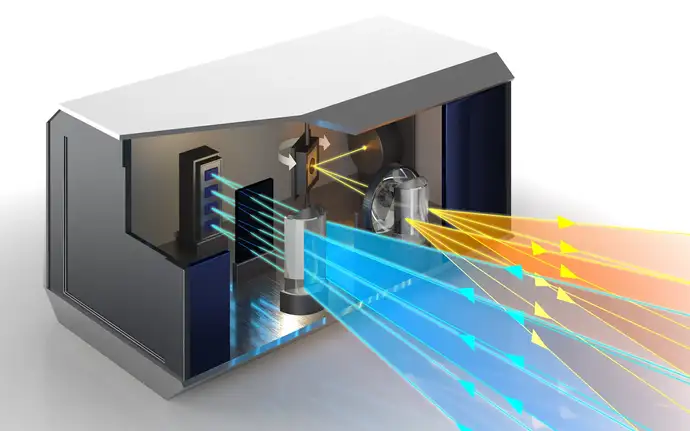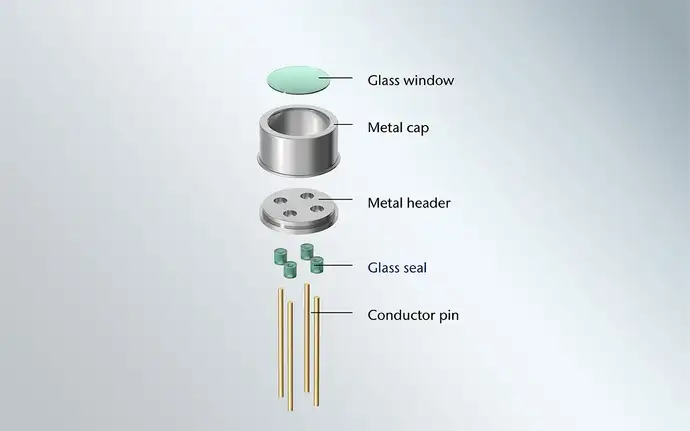The key to LiDAR safety
Safety is the name of the game for assisted and fully autonomous driving
LiDAR, or light detection and ranging, is one of the most important technologies enabling autonomous driving. It uses eye-safe lasers to scan the vehicle’s surroundings to distances of more than 250 meters away. As the photodiodes collect signals, high powered processors create a real-time, high-resolution 3D point-cloud image of the environment. In many systems, camera and radar technologies enhance the point cloud details and provide the crucial redundancy needed for higher levels of autonomous driving (Level 3 and beyond), which includes full automation of driving functions under all conditions.

LiDAR sensors in the system collect data and create a real-time, high-resolution 3D points-cloud map of the environment
Safe autonomous driving requires accurate LiDAR signals
While significant strides have been made in developing consistently safe and reliable autonomous driving systems, there are still some issues to be conquered. One issue is the quality of optical signal transmission in LiDAR systems. The challenge lies in the fact that LiDAR sensors must be extremely precise but are primarily installed on the outside of vehicles. This leaves the sensors exposed to harsh conditions such as extreme temperature, high humidity, and UV rays as well as increased shock and vibration. These hazards could damage or even destroy the sensitive inner components of the system, including laser diodes, MEMS mirrors, and signal-receiving photodiodes.
Moisture intrusion is what many developers fear most. If a water droplet ends up on critical and sensitive components like laser emitters, lenses, or galvo mirrors, it could cause significant performance reduction, a blind spot, or even catastrophic failure of the sensor. In a self-driving car, this could lead to incorrect operation and even traffic accidents, both life-threatening safety risks.

High-quality packaging components are essential for accurate optical signals
The harsh conditions experienced in driving environments combined with extreme optical performance requirements means that sensitive LiDAR components need robust, vacuum-tight packaging. Furthermore, to establish LiDAR technology in mass-market automotive applications, absolute safety, reliability, and durability are crucial. Packages for LiDAR sensors must enable stable and high-performance optical signal transmission – not just for a few hours or days, but consistently over many years.
Selecting the right packaging technology is critical for automotive applications
When it comes to hermetic sensor packaging, there are different types of technologies available. One of the most common highest performing technologies for harsh-environment automotive and opto-electronic sensor packaging is glass-to-metal sealing, abbreviated as GTMS. Hermetic packaging using GTMS technology fully encapsulates the sensor components in inorganic materials. Metal housing components are combined with electrical conductors utilizing technical glasses and metal brazes to provide an impermeable and virtually non-aging enclosure around a component or entire sensor. Gas and moisture cannot penetrate through the glass seal, which maintains high hermeticity levels on a near-permanent basis. In comparison, non-hermetic sealing materials, such as polymers, age naturally over time and cannot maintain a truly hermetic environment.Using glass-to-metal sealing technology, optical windows can be added to provide an optical path through the walls of the sensor. A variety of high quality glass windows are available to provide the best transmission for your material combination and wavelength. Bandpass and high-pass filter coatings minimize optical noise to increase your signal to noise ratio.
Glass-to-metal seals deliver exceptional robustness
An important consideration for glass-to-metal seals is selecting the right combination of specialty glass and metal. It is key that the two materials have appropriate coefficients of thermal expansion (CTE) because glass and metal typically expand or shrink differently during the sealing process. A carefully selected combination also enables the materials to be bonded together directly without any additional interface materials. Once melted together, the resulting glass and metal package can durably withstand even the most extreme pressures and temperature variations experienced by automobiles.
The typical pin design of a GTMS package – also referred to as a through-hole design – allows the sensor package to be tightly connected with a printed circuit board (PCB). The electrical contact pins can be inserted into and tightly fixed to the PCB using solder, which makes the assembly highly shock and vibration resistant. In addition, GTMS packages can be designed in a surface mount device (SMD) style. This style provides short pins that can be used for pick-and-place assembly with industry standard circuit board assembly techniques.

The right packaging partner can support your entire development journey
In this newly emerging field, a number of LiDAR sensor technologies are currently in the race. This includes rotating sensors, MEMS scanners, semiconductor arrays, and photonic systems. Although LiDAR sensor packaging requirements differ across technologies and customers, companies producing LiDAR systems all need a partner that understands high reliability electronic packaging, has advanced capabilities, and is experienced in automotive methods. This trusted partner must be capable of supporting each development step – from research and prototyping all the way to volume production – with consistently high quality.
Want to know more? Let's talk
Whether you need more information, samples, a quote, or advice for a project, I would be delighted to talk to you.


